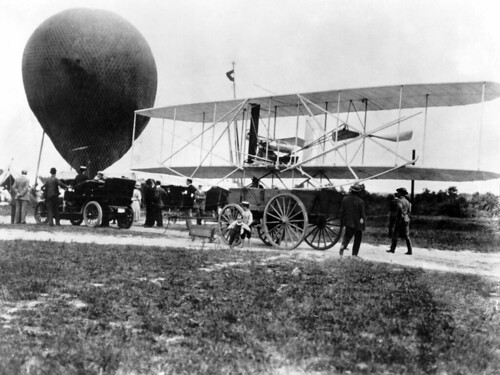The first flight of a fixed wing aircraft in Europe takes place.
In 1906, the Brazilian Alberto Santos-Dumont made public flights in France with his 14-bis. A canard pusher biplane with pronounced wing dihedral, it had a Hargrave-style box-cell wing with a forward-mounted “boxkite” assembly which was movable to act as both elevator and rudder. He later added auxiliary surfaces between the wings as primitive ailerons to provide lateral control. His flight was the first made by a powered heavier-than-air machine to be verified by the Aéro-Club de France, and won the Deutsch-Archdeacon Prize for the first officially observed flight of more than 25 metres. It later set the first world record recognized by the Federation Aeronautique Internationale by flying 220 metres in 21.5 seconds.
The next year Louis Blériot flew the Blériot VII, a tractor monoplane with full three-axis control using the horizontal tail surfaces as combined elevators and ailerons. Its immediate descendant, the Blériot VIII, was the very first airframe to bring together the recognizable elements of the modern aircraft flight control system in April 1908. Where Horatio Phillips and Traian Vuia had failed, Blériot’s was the first practical tractor monoplane and marked the start of a trend in French aviation. By 1909, he had developed this configuration to the point where the Blériot XI was able to cross the English Channel, among other refinements using the tail surfaces only as elevators and using wing warping for lateral control.
Another design that appeared in 1907 was the Voisin biplane. This lacked any provision for lateral control, and could only make shallow turns using only rudder control, but was flown with increasing success during the year by Henri Farman, and on 13 January 1908 he won the 50,000 francs Deutsch de la Meurthe-Archdeacon Grand Prix de l’Aviation for being the first aviator to complete an officially observed 1 kilometre closed circuit flight, including taking off and landing under the aircraft’s own power.

